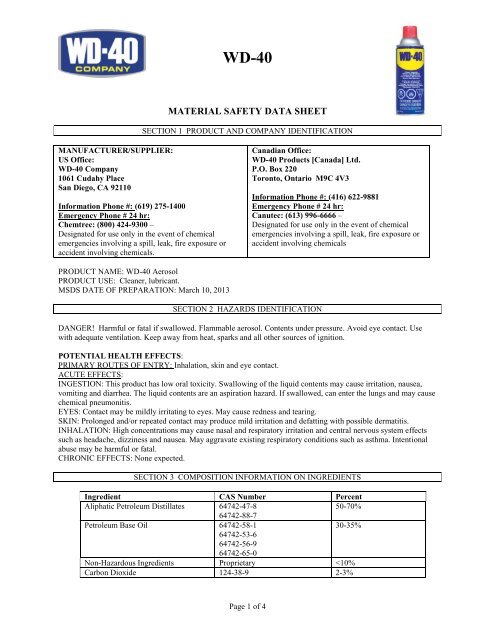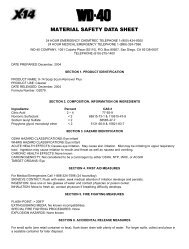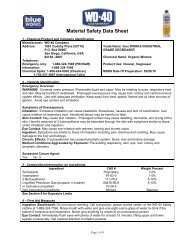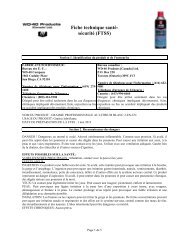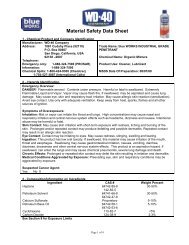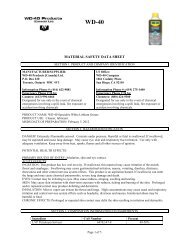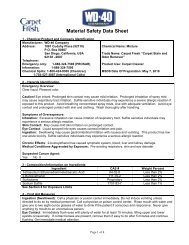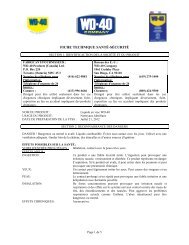MATERIAL SAFETY DATA SHEET - WD-40 Company
MATERIAL SAFETY DATA SHEET - WD-40 Company
MATERIAL SAFETY DATA SHEET - WD-40 Company
Create successful ePaper yourself
Turn your PDF publications into a flip-book with our unique Google optimized e-Paper software.
<strong>WD</strong>-<strong>40</strong><br />
<strong>MATERIAL</strong> <strong>SAFETY</strong> <strong>DATA</strong> <strong>SHEET</strong><br />
SECTION 1 PRODUCT AND COMPANY IDENTIFICATION<br />
MANUFACTURER/SUPPLIER:<br />
US Office:<br />
<strong>WD</strong>-<strong>40</strong> <strong>Company</strong><br />
1061 Cudahy Place<br />
San Diego, CA 92110<br />
Information Phone #: (619) 275-1<strong>40</strong>0<br />
Emergency Phone # 24 hr:<br />
Chemtrec: (800) 424-9300 –<br />
Designated for use only in the event of chemical<br />
emergencies involving a spill, leak, fire exposure or<br />
accident involving chemicals.<br />
Canadian Office:<br />
<strong>WD</strong>-<strong>40</strong> Products [Canada] Ltd.<br />
P.O. Box 220<br />
Toronto, Ontario M9C 4V3<br />
Information Phone #: (416) 622-9881<br />
Emergency Phone # 24 hr:<br />
Canutec: (613) 996-6666 –<br />
Designated for use only in the event of chemical<br />
emergencies involving a spill, leak, fire exposure or<br />
accident involving chemicals<br />
PRODUCT NAME: <strong>WD</strong>-<strong>40</strong> Aerosol<br />
PRODUCT USE: Cleaner, lubricant.<br />
MSDS DATE OF PREPARATION: March 10, 2013<br />
SECTION 2 HAZARDS IDENTIFICATION<br />
DANGER! Harmful or fatal if swallowed. Flammable aerosol. Contents under pressure. Avoid eye contact. Use<br />
with adequate ventilation. Keep away from heat, sparks and all other sources of ignition.<br />
POTENTIAL HEALTH EFFECTS:<br />
PRIMARY ROUTES OF ENTRY: Inhalation, skin and eye contact.<br />
ACUTE EFFECTS:<br />
INGESTION: This product has low oral toxicity. Swallowing of the liquid contents may cause irritation, nausea,<br />
vomiting and diarrhea. The liquid contents are an aspiration hazard. If swallowed, can enter the lungs and may cause<br />
chemical pneumonitis.<br />
EYES: Contact may be mildly irritating to eyes. May cause redness and tearing.<br />
SKIN: Prolonged and/or repeated contact may produce mild irritation and defatting with possible dermatitis.<br />
INHALATION: High concentrations may cause nasal and respiratory irritation and central nervous system effects<br />
such as headache, dizziness and nausea. May aggravate existing respiratory conditions such as asthma. Intentional<br />
abuse may be harmful or fatal.<br />
CHRONIC EFFECTS: None expected.<br />
SECTION 3 COMPOSITION INFORMATION ON INGREDIENTS<br />
Ingredient CAS Number Percent<br />
Aliphatic Petroleum Distillates 64742-47-8<br />
50-70%<br />
64742-88-7<br />
Petroleum Base Oil 64742-58-1<br />
30-35%<br />
64742-53-6<br />
64742-56-9<br />
64742-65-0<br />
Non-Hazardous Ingredients Proprietary
<strong>WD</strong>-<strong>40</strong> Aerosol<br />
03/10/13<br />
SECTION 4 FIRST AID MEASURES<br />
For Medical Emergencies Call 1-888-324-7596 (24 hours/day)<br />
INGESTION: Aspiration Hazard. DO NOT induce vomiting. Call physician, poison control center or the <strong>WD</strong>-<strong>40</strong><br />
Safety Hotline at 1-888-324-7596 immediately.<br />
EYE CONTACT: Flush thoroughly with water. Get medical attention if irritation persists.<br />
SKIN CONTACT: Wash with soap and water. If irritation develops and persists, get medical attention.<br />
INHALATION: If irritation is experienced, move to fresh air. Get medical attention if irritation or other symptoms<br />
develop and persist.<br />
SECTION 5 FIRE FIGHTING MEASURES<br />
EXTINGUISHING MEDIA: Use water fog, dry chemical, carbon dioxide or foam. Do not use water jet or flooding<br />
amounts of water. Burning product will float on the surface and spread fire.<br />
SPECIAL FIRE FIGHTING PROCEDURES: Firefighters should always wear positive pressure self-contained<br />
breathing apparatus and full protective clothing. Cool fire-exposed containers with water. Use shielding to protect<br />
against bursting containers.<br />
UNUSUAL FIRE/EXPLOSION HAZARDS: Contents under pressure. Aerosol containers may burst under fire<br />
conditions. Vapors are heavier than air and may travel along surfaces to remote ignition sources and flash back.<br />
SECTION 6 ACCIDENTAL RELEASE MEASURES<br />
SPILL RESPONSE: Wear appropriate protective clothing (see Section 8). Eliminate all sources of ignition and<br />
ventilate area. Leaking cans should be placed in a plastic bag or open pail until the pressure has dissipated. Contain<br />
and collect liquid with an inert absorbent and place in a container for disposal. Clean spill area thoroughly. Report<br />
spills to authorities as required.<br />
SECTION 7 HANDLING AND STORAGE<br />
HANDLING: Avoid contact with eyes. Avoid prolonged contact with skin. Avoid breathing vapors or aerosols. Use<br />
with adequate ventilation. Keep away from heat, sparks and open flames. Wash thoroughly with soap and water<br />
after handling. Do not puncture or incinerate containers. Keep can away from electrical current or battery terminals.<br />
Electrical arcing can cause burn-through (puncture) which may result in flash fire, causing serious injury. Keep out<br />
of the reach of children.<br />
STORAGE: Do not store above 120F or in direct sunlight. U.F.C (NFPA 30B) Level 3 Aerosol.<br />
SECTION 8 EXPOSURE CONTROLE/PERSONAL PROTECTION<br />
OCCUPATIONAL EXPOSURE LIMITS:<br />
Aliphatic Petroleum Distillates<br />
Petroleum Base Oil<br />
Non-Hazardous Ingredients<br />
Carbon Dioxide<br />
1200 mg/m3 TWA Manufacturer Recommended<br />
5 mg/m3 TWA ACGIH TLV<br />
10 mg/m3 STEL ACGIH TLV<br />
None Established<br />
5000 ppm TWA, 30,000 ppm STEL ACGIH TLV<br />
The Following Controls are Recommended for Normal Consumer Use of this Product<br />
Engineering Controls: Use in a well-ventilated area.<br />
Personal Protection:<br />
Eye Protection: Avoid eye contact. Safety glasses or goggles recommended.<br />
Skin Protection: Avoid prolonged skin contact. Chemical resistant gloves recommended for operations where skin<br />
contact is likely.<br />
Respiratory Protection: None needed for normal use with adequate ventilation.<br />
Page 2 of 4
<strong>WD</strong>-<strong>40</strong> Aerosol<br />
03/10/13<br />
For Bulk Processing or Workplace Use the Following Controls are Recommended<br />
Engineering Controls: Use adequate general and local exhaust ventilation to maintain exposure levels below that<br />
occupational exposure limits.<br />
Personal Protection:<br />
Eye Protection: Safety goggles recommended where eye contact is possible.<br />
Skin Protection: Wear chemical resistant gloves.<br />
Respiratory Protection: None required if ventilation is adequate. If the occupational exposure limits are exceeded,<br />
wear a NIOSH approved respirator. Respirator selection and use should be based on contaminant type, form and<br />
concentration. Follow applicable regulations and good Industrial Hygiene practice.<br />
Work/Hygiene Practices: Wash with soap and water after handling.<br />
SECTION 9 PHYSICAL <strong>DATA</strong><br />
APPEARANCE AND ODOR: Light amber liquid with a mild odor.<br />
Boiling Point: 361 - 369F (183 - 187°C) Specific Gravity: 0.8 – 0.82 @ 60F<br />
Solubility in Water: Insoluble pH: Not Applicable<br />
Vapor Pressure: 95-115 PSI @ 70F Vapor Density: Greater than 1<br />
Percent Volatile: 70-75% VOC: 412 grams/liter (49.5%)<br />
Coefficient of Water/Oil Not Determined<br />
Kinematic 2.79-2.96cSt @ 100F<br />
Distribution:<br />
Flash Point:<br />
122F (49°C) Tag Open Cup<br />
(concentrate)<br />
Pour Point: -63C (-81.4F ) ASTM D-97<br />
Viscosity:<br />
Flammable Limits:<br />
(Solvent Portion)<br />
SECTION 10 STABILITY AND REACTIVITY<br />
LEL: 0.6% UEL: 8.0%<br />
STABILITY: Stable<br />
INCOMPATIBILITY: Strong oxidizing agents. Avoid heat and open flames. Do not puncture or incinerate<br />
containers.<br />
HAZARDOUS DECOMPOSITION PRODUCTS: Carbon monoxide, carbon dioxide.<br />
SECTION 11 TOXICOLOGICAL INFORMATION<br />
The oral toxicity of this product is estimated to be greater than 5,000 mg/kg based on an assessment of the<br />
ingredients. This product is not classified as toxic by established criteria. It is an aspiration hazard.<br />
None of the components of this product is listed as a carcinogen or suspected carcinogen or is considered a<br />
reproductive hazard.<br />
No data is currently available.<br />
SECTION 12 ECOLOGICAL INFORMATION<br />
SECTION 13 DISPOSAL CONSIDERATIONS<br />
WASTE DISPOSAL METHOD: If this product becomes a waste, it would be expected to meet the criteria of a<br />
hazardous waste based on flammability. However, it is the responsibility of the generator to determine at the time of<br />
disposal the proper classification and method of disposal. Dispose in accordance with federal, state, and local<br />
regulations.<br />
SECTION 14 TRANSPORT INFORMATION<br />
DOT Surface Shipping Description: Consumer Commodity, ORM-D<br />
After 1/1/2014 UN1950, Aerosols, 2.1 Ltd. Qty (Note: Shipping Papers are not required for Limited<br />
Quantities unless transported by air or vessel – each package must be marked with the Limited<br />
Page 3 of 4
<strong>WD</strong>-<strong>40</strong> Aerosol<br />
03/10/13<br />
Quantity Mark)<br />
Canadian TDG Classification: Limited Quantity<br />
IMDG Code Hazard Classification: UN1950, Aerosols, 2.1.<br />
U.S. FEDERAL REGULATIONS:<br />
SECTION 15 REGULATORY INFORMATION<br />
CERCLA 103 Reportable Quantity: This product is not subject to CERCLA reporting requirements, however, oil spills<br />
are reportable to the National Response Center under the Clean Water Act and many states have more stringent release<br />
reporting requirements. Report spills as required under federal, state and local regulations.<br />
SARA TITLE III:<br />
Hazard Category For Section 311/312: Acute Health, Fire Hazard, Sudden Release of Pressure<br />
Section 313 Toxic Chemicals: This product contains the following chemicals subject to SARA Title III Section 313<br />
Reporting requirements: None<br />
Section 302 Extremely Hazardous Substances (TPQ): None<br />
EPA Toxic Substances Control Act (TSCA) Status: All of the components of this product are listed on the TSCA<br />
inventory.<br />
CANADIAN REGULATIONS:<br />
Canadian Environmental Protection Act: All of the ingredients are listed on the Canadian Domestic Substances List<br />
or exempt from notification<br />
Canadian WHMIS Classification: Class B-5 (Flammable Aerosol).<br />
This MSDS has been prepared according to the criteria of the Controlled Products Regulation (CPR) and the MSDS<br />
contains all of the information required by the CPR.<br />
SECTION 16 OTHER INFORMATION<br />
HMIS Hazard Rating: Health – 1 (slight hazard), Fire Hazard – 4 (severe hazard), Physical Hazard – 0<br />
(minimal hazard)<br />
Revision Date: 03/10/13 Supersedes: 07/21/12<br />
Prepared By: Industrial Health & Safety Consultants, Inc. 1-203-929-3473<br />
This MSDS complies with OSHA guidelines set by 29 CFR 1910.1200 and the Canadian WHMIS regulations. The<br />
foregoing information has been compiled from sources believed to be accurate but is not warranted to be. Recipients<br />
are advised to confirm in advance of need that data is correct. Standards change without notice. It is the<br />
responsibility of the recipient to insure that their personnel have been notified of any changes which may affect<br />
them. The data provided on this MSDS are not meant to be used as specifications, only as guideline information as<br />
to the safe use of this product. User should refer to applicable laws before use.<br />
N/D = Not Determined N/E = Not Established N/A = Not Applicable<br />
1014100 / No. 0084101<br />
Page 4 of 4


